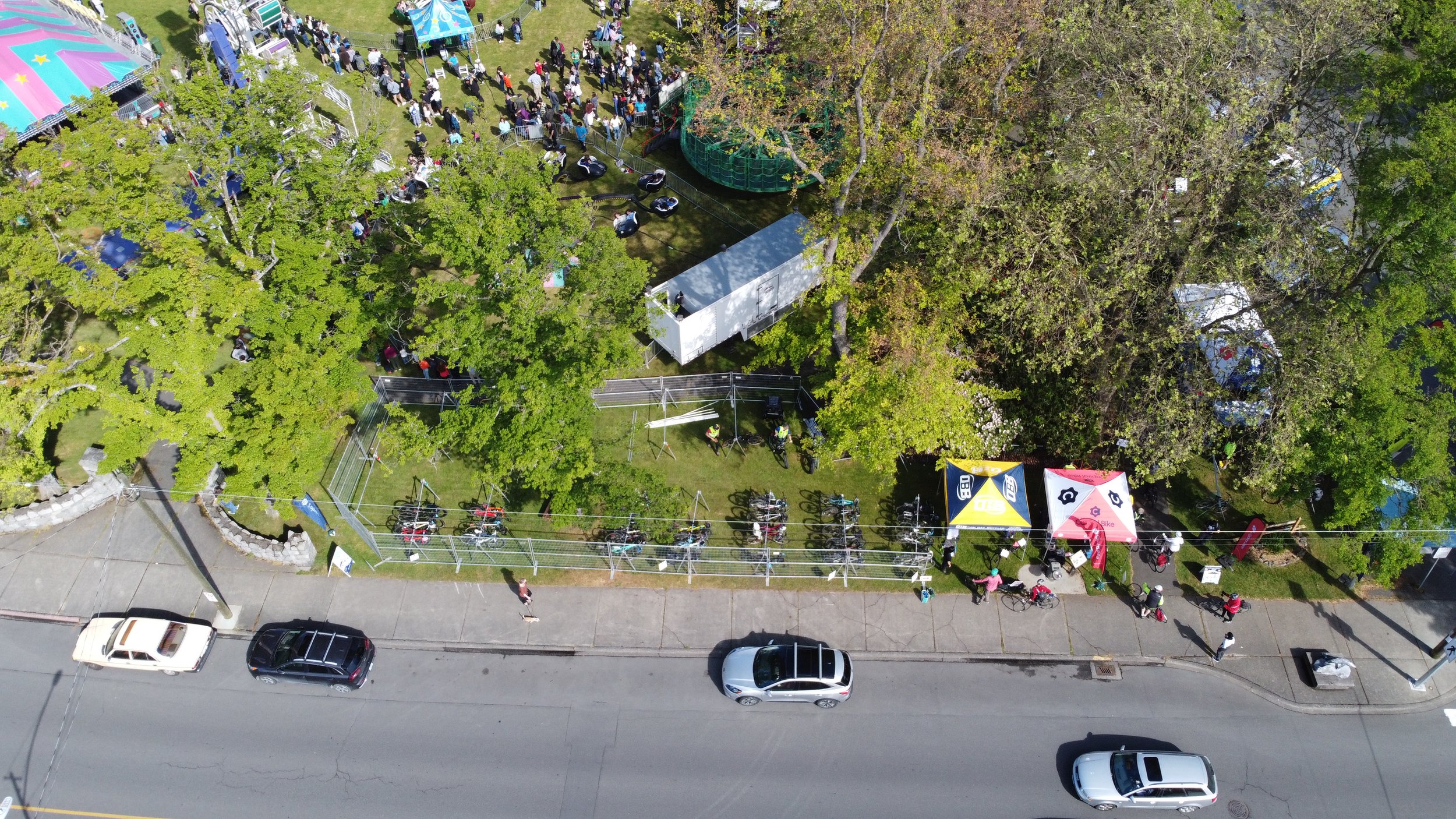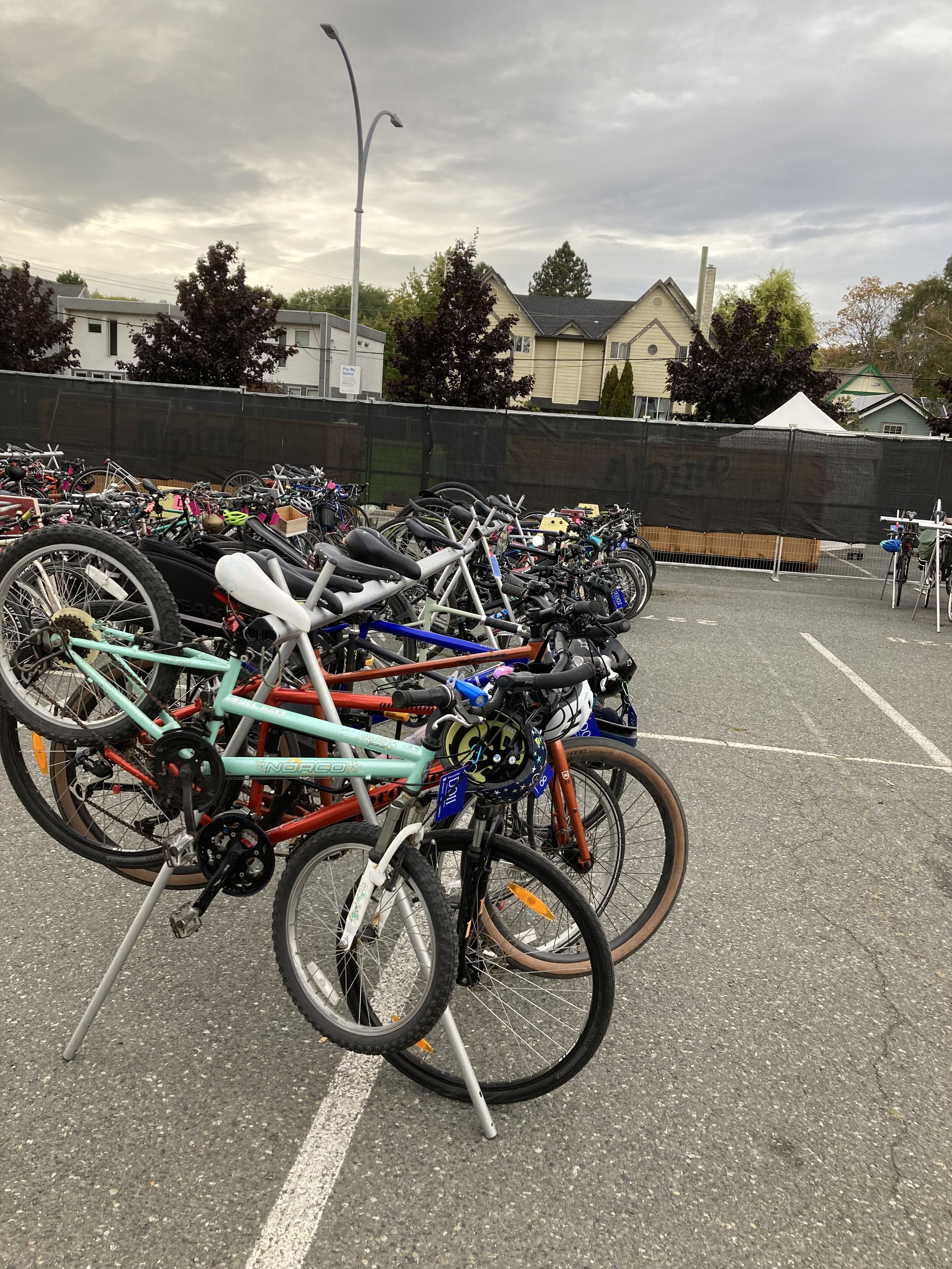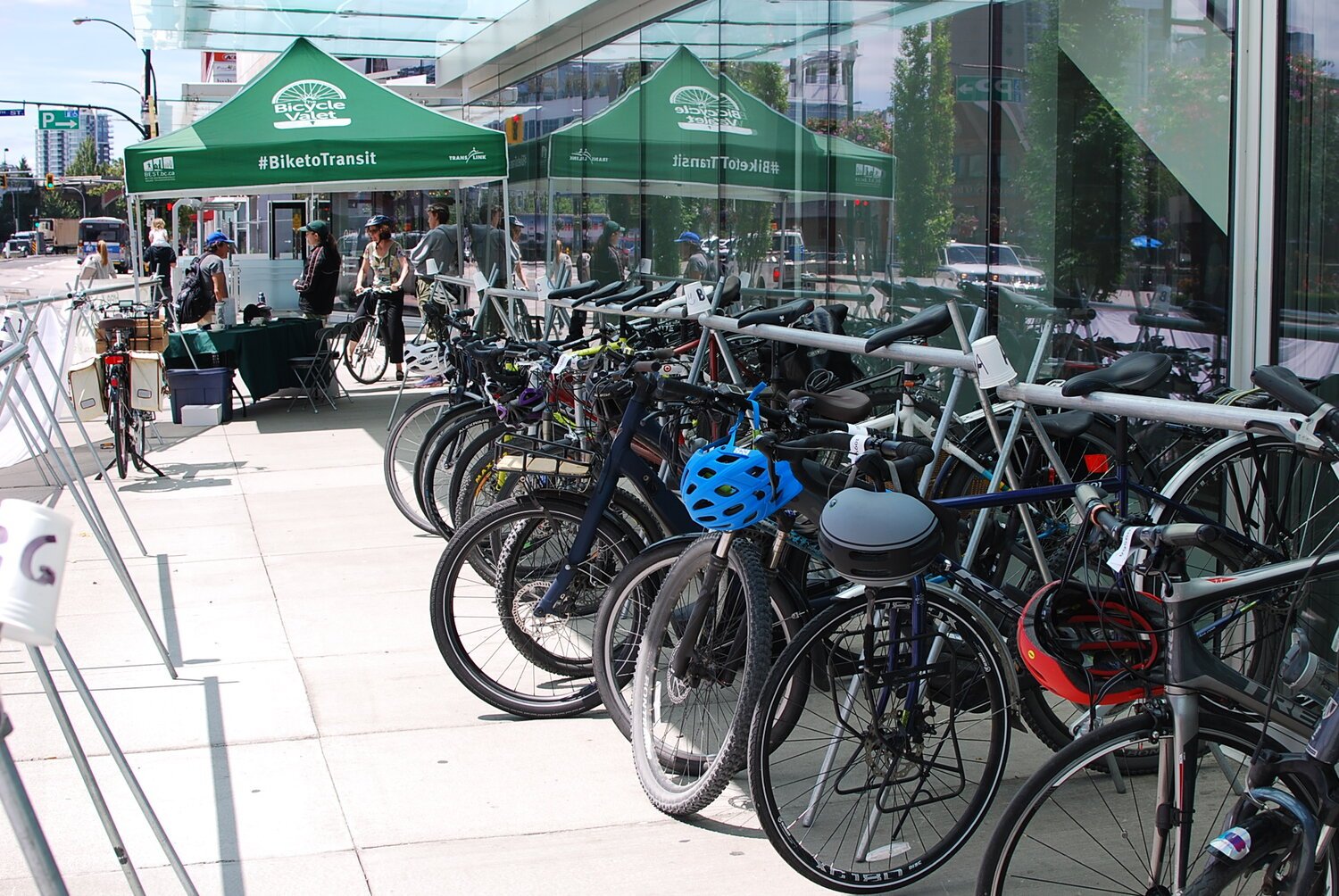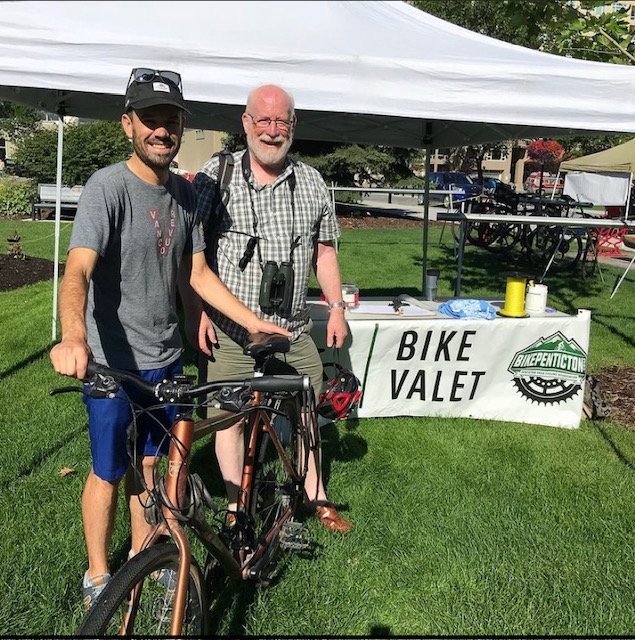What is a Bike Valet?




This page explains what a bike valet is and how one works in general terms. For resources such as editable bike valet operating procedures, safety plans, check out BCCC's Bike Valet Toolkit.
Summary
- A bike valet is a coatcheck for bikes—and so much more!
- Different models of valets are geared towards different needs, from permanent installations to event-focussed models
- Initial investment does not have to be large to get started— less than $1000.
Table of Contents
- What is a Bike Valet?
- Event Bike Valet
- Fixed Location Bike Valet
- Essential elements
- Racks and More
- Bike Tracking System
- Enclosure
- Staff
- Data Tracking and Analytics
- Successful Bike Valets in BC
- How to Advertise
What is a Bike Valet?
A bike valet is a coatcheck for bikes and other mobility devices such as scooters and skateboards. Customers drop off their ride, and valet staff park it for them. Bike valets are unique because they feature a secure and efficient parking area where only staff can enter. When customers return for their bike, valet staff retrieve it. This renders locks unnecessary and protects people's lights, panniers, and the bike itself.
Broadly, there are two types of bike valets: event bicycle valets and fixed location valets. Event valets are set up for short-term bicycle parking for an event such as a farmers' market or music festival. They might be set up for as long as a week or for just a few hours. Fixed-location valets serve an area over months, years, or permanently where valet infrastructure can be built and developed over time. These different valets serve different needs and provide benefits suited to the situation and clients. Both types of valet are highly effective at preventing bike theft.
Beyond the connivance, the most important benefit of bike valets is that riders can leave their bikes, belongings, and lights without worry. This especially affects families who often have to carry many items for their children (strollers are also a form of transport bike valets can store!). Families, older riders, and all e-bike users especially benefit from having a safe place to store their rides which are often too valuable to lock up safely.
Bike valets pair well with anti-bike theft programs such as Project 529 and are excellent sites for outreach to riders.
Bike valets most benefit families, older riders, and riders with disabilities, as these riders often have specialized needs, more items to carry with them, or cycles that are harder or more expensive to replace.
Perhaps the most important benefit of bike valets is that riders can leave their belongings and lights with their bikes without worry. This especially affects families who often have to carry many items for their children remember also, strollers are also a form of transport!). Families and older riders also disproportionately benefit from having a safe place to store their e-bikes which are often too valuable to lock up safely.
Bike valets pair well with anti-bike theft programs such as Project 529 and are excellent sites for outreach to people that ride bikes.
Event Bike Valet
Summary
Event bike valet:
- Meets short-term secure parking needs
- Encourages cyclists ride to events, especially e-bikes
- Encourages young families to ride
- Equipment is lightweight and portable
- Setup and takedown are fast and efficient
Bike valet for events provides lots of bike parking (for dozens or hundreds of riders) in places that are otherwise not suited to high volumes of bike traffic. With a bike valet, organizers no longer need to worry about attendees locking their bikes to infrastructure such as fences and gates, and riders can safely bring their bikes without worrying. Bike valets are particularly valuable at events with limited parking, traffic issues, or lots of cyclists. Event bike valets near cycling infrastructure will be particularly useful— which is valuable to keep in mind when planning. Sometimes to get people cycling to events, a valet is not enough and organizers will need to work with local government to set up infrastructure to ensure people feel safe cycling.
Event bike valets generally use lightweight portable racks, portable fencing, and pop-up tents. A bike can even deliver a small events' gear with the right equipment.
Fixed-Location Bike Valet
Summary
Fixed-location bike valet:
- Provides bike valet services in a single location over a longer timeframe
- Uses heavier-duty equipment and infrastructure
- Are best deployed in areas where ridership is being limited because of the perception that riders' bikes or items might be stolen
- Allows for high-quality data collection and outreach
Fixed-location bike valets provide lots of secure bike parking (100+ bikes) over the long term in areas where it is not appropriate or safe to lock up a bike, or where the provision of locking infrastructure does not make sense or has not yet been built. Appropriate situations may include:
- Stadiums or other event venues with high traffic, where the volume of people in and out mean locking infrastructure would be prohibitively expensive to build and maintain,
- Areas with high perceptions of bike theft, and
- Shopping areas where people want to leave items with their bikes. Optimally, these circumstances are combined with the presence of bike-friendly streets and infrastructure.
Fixed-location bike valets allow for developed bike-parking infrastructure, including heavy-duty racks, permanent structures for storage and staff, permanent fencing, and better data tracking relative to event bike valets.
Essential Elements
These are the basic elements needed to run a valet safely and efficiently. More info on all of these can be found in our BCCC Bike Valet Toolkit.
Racks and More
Triathlon-style racks can hold as many as 10 bikes in a single car space, with room to maneuver.
Most e-bikes and cargo bikes come with kickstands, but regular bikes need to be parked with a valet rack. These racks are not the type of rack that one might see outside a store as they are not for locking bikes to. Rather, they are triathlon-style racks where bikes hang by their seat-posts. Triathlon-style racks are ideal for a valet as it takes only seconds for a valet to hang up a bike. Bikes on triathlon-style racks take up very little room, a key advantage in valets where space is often at a premium. Furthermore, good racks can be picked up with all of the bikes still on them and adjusted, with one staff member lifting each end of the rack.
Wooden frames made from pallet wood can also work but will not last under heavy use and are less portable. They also risk damaging the wheels of bikes. Some types of portable fencing can also be used as racks, with similar issues. These impromptu rack solutions are cheap to acquire but are difficult to store and transport, so they are suitable only for a limited number of events. A professional valet should obtain good triathlon-style racks as soon as is feasible.
When working on grass, especially after rain, e-bikes are at risk of falling over. To prevent this, a valet will also need some plywood squares, about 15cm (6") square, to place under the kickstands. Make sure to sand them to prevent splinters!
Tag System
Tag pairs like these can be used to mark and organize bikes. Each tag should be unique. Colours should be chosen so as to avoid confusion, and should also be indicated in the code or by some other means to allow for colour-blind staff.
Like any coat checking system, bike valets use tags to return bikes to their owners. Tags can be disposable or reusable, and customers' copies can even be digital (although this is not recommended for bike valets with heavy traffic or poor cell signal). As long as a tag system is trackable, unique, and sortable, it should work.
- Trackable: can be used to keep track of how many bikes have been parked, and when
- Unique: it is not possible for bikes and owners to get mixed up.
- Sortable: bikes can be sorted by different types (e-bikes, oversize bikes, regular bikes) and by tag number/category so staff can easily find them without looking through the entire valet enclosure.
Enclosure
Enclosures should be fully surrounded by fencing or some other barrier that prevents theft of not only bikes but also bags and lights. In this example, the valet is set up in the corner of two chain link fences, and temporary event fencing and a wall of tents is used to make the third and forth side. The entrance to the valet is guarded by valet staff.
A valet needs an enclosure. Enclosures are best made from metal fencing, such as chain link or temporary fencing. For any fence height under 5' or 150cm, bikes should be parked away from the fence. Temporary plastic fencing is a cheaper but less secure option. If you have a surplus of racks, they can also be used as fencing in combination with tarps, banners, or rollable plastic fencing.
Staff
Every valet shift should have at least two people. This allows staff or volunteers to take breaks one at a time while the other staff member(s) guard the bikes and are available to serve customers.
Data Tracking
Ideally, valets should keep track of when each customer arrives and departs. At a minimum, valets should keep track of how many and what type of bikes they park. A good bike tracking system makes this easy. All valets should also provide a survey asking about the customer experience of using the valet and if it affected their choice of how they got to their destination.
Successful Bike Valets in BC
Professional services
- BEST's Bike Valet (Vancouver)
- Capital Bike's The Locker (Victoria)
Limited Services or Single Locations
Some ideas on how to advertise bike valet services
- For event organizers: Parking is essential for many events and a lack of parking can cause events to shut down, such as with Metchosin Day. As a single car space can fit more than ten bikes, Bike valet can help relieve pressure on event organizers by providing alternatives to car parking.
- For businesses: Bike valets can help attract business to an area by providing an attractive amenity to shoppers.
- For local government: Bike valet prevents bike theft.



